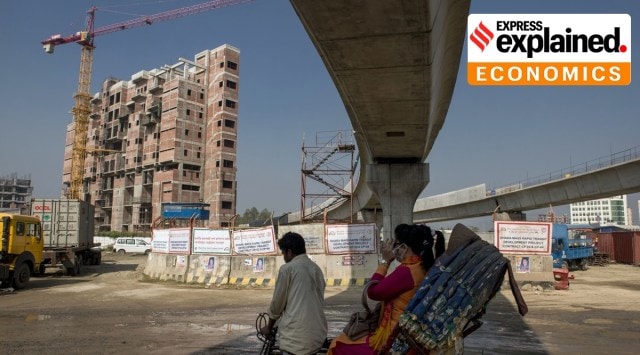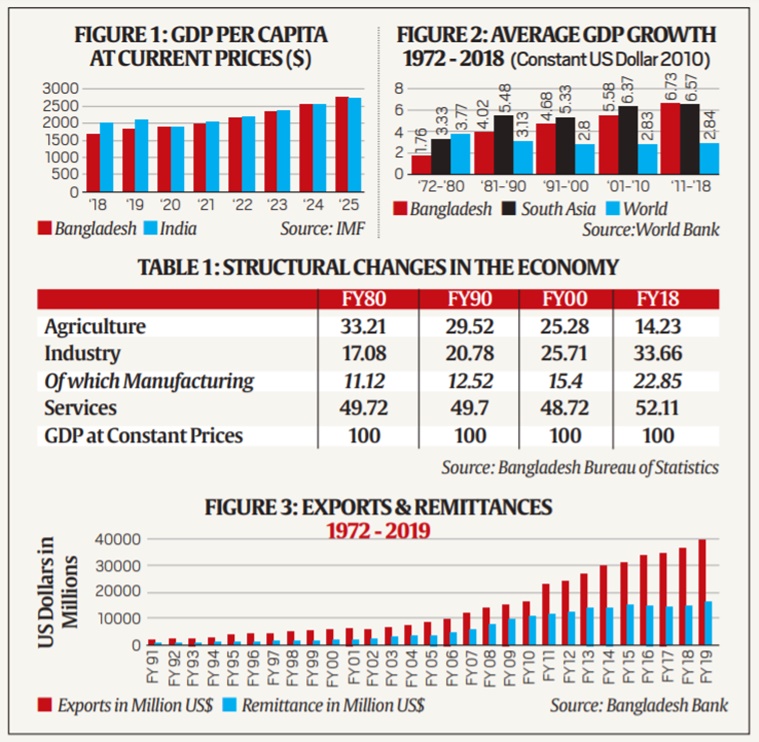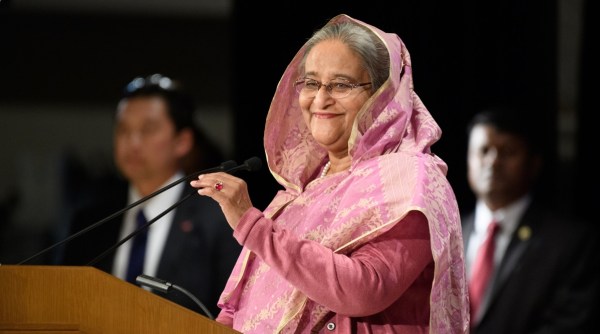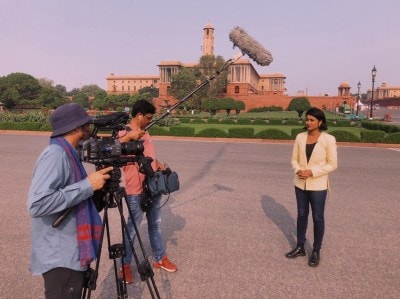- India
- International
An Expert Explains: How Bangladesh has reduced gap — and is now projected to overtake India
Taking a long view, it is evident that the economic growth of Bangladesh has been steady over the past four decades. Following some turbulence in the years after independence due to famine and natural disasters, overall progress since the 1990s has been good.
 A rickshaw travels past an under construction elevated line for the Dhaka Mass Rapid Transit Co. metro in Diabari, Dhaka, Bangladesh. (Bloomberg Photo: Ismail Ferdous)
A rickshaw travels past an under construction elevated line for the Dhaka Mass Rapid Transit Co. metro in Diabari, Dhaka, Bangladesh. (Bloomberg Photo: Ismail Ferdous)About two years ago, India’s Home Minister Amit Shah spoke of “infiltrators” who were hollowing out the country “like termites”. A Minister from Bangladesh retorted that Shah’s statement was “inappropriate”, “unwanted”, and “not based on information”. The IMF’s recent per capita GDP projections for South Asian countries show that the alleged ‘termite factory’ is shining — Bangladesh, which has been doing better than both India and Pakistan on social and human development indicators for several years now, is also beginning to march ahead on the economic front.
Development economists Jean Drèze and Amartya Sen showed in their 2013 book, An Uncertain Glory: India and its Contradictions, that Bangladesh had been outshining its larger neighbours on indicators such as infant mortality, child immunisation, female literacy, access to improved sanitation, and total fertility rate. When the nation was born in 1971, the average Bangladeshi could expect to live for only 46.5 years, two years less than the average Indian. By 2018, life expectancy in Bangladesh had risen to 72 years, two years more than India’s. Bangladesh lagged behind India in only one major economic dimension — income per capita, which in 2015 was approximately 25% less than India’s. But if the IMF’s latest projections are accurate, the gap is set to disappear, and Bangladesh and India are expected to be neck and neck until 2025.
Dr Ashikur Rahman is a Senior Economist at the Policy Research Institute of Bangladesh, Dhaka
To see this as a one-year phenomenon arising out of the pandemic induced (-)10% growth in India while Bangladesh registered a (+)3.8% growth, would be a mistake. Each social or economic indicator seeks to capture a certain aspect of human welfare — and when a country consistently does better across a range of indicators, an “economic catch-up” too, is entirely likely. Most analysts in Bangladesh have been seeing this coming for quite some time — the Covid-19 outbreak might have simply expedited this process.
So, what has allowed Bangladesh to turn the corner?
The economic story of Bangladesh has not always been optimistic. Soon after independence, then United States Secretary of State Henry Kissinger (in)famously branded Bangladesh as a “bottomless basket”, and development pundits did not believe that an overcrowded country with very few natural resources had great economic prospects. These prophesies obviously did not account for incremental improvements in social and economic indicators over time.
 Source: Bangladesh Bank
Source: Bangladesh Bank
From 2009 onward, the government of Prime Minister Sheikh Hasina has demonstrated a strong political will to uproot Islamic terrorism and establish peace, along with a sustained policy commitment to macroeconomic stability through prudent fiscal and international debt management, expansion of the social security net, and execution of mega infrastructure projects. One of the Prime Minister’s most significant achievements has been to successfully balance the competing interests of India, China, Japan, Russia and the US, which has allowed Bangladesh to protect its national interest and develop a win-win political and economic rapport with major global powers.

Also in Explained | What is the economic cost of being ‘filthy India’?
 Bangladesh’s Prime Minister Sheikh Hasina speaks at a conference in Tokyo, Japan in 2019. (Bloomberg Photo: Akio Kon)
Bangladesh’s Prime Minister Sheikh Hasina speaks at a conference in Tokyo, Japan in 2019. (Bloomberg Photo: Akio Kon)
Taking a long view, it is evident that the economic growth of Bangladesh has been steady over the past four decades. Following some turbulence in the years after independence due to famine and natural disasters, overall progress since the 1990s has been good. Consider:
* Average GDP growth for Bangladesh has been higher than the world’s average GDP growth over the last three decades; it has been higher than the average growth rate of South Asia since 2010. Bangladesh’s average economic growth has steadily increased in each decade since 1980. In 2018, Bangladesh emerged as one of the fastest growing economies in the world.
* The contribution of agriculture in Bangladesh’s GDP has declined steadily, while that of manufacturing and services has increased (Table 1). In 1980, agriculture accounted for almost a third of the GDP; industry for less than a fifth. In 2018, the contribution of agriculture to GDP had fallen to less than 15%, and industry now accounts for more than a third. The contribution of the manufacturing sector to GDP has doubled since 1980.
*Exports have been buoyant since the 1990s (Figure 3). They have risen from less than US $2 billion in FY92 to more than US $40 billion in FY19 – growth by a factor of (approximately) 20 in 37 years.
* Figure 3 also shows remittances have risen fast after FY91, from approximately US $764 million to more than US $16.4 billion in FY19. Bangladesh is among the world’s top 10 remittance receiving countries, even though the difference in remittance earnings of Bangladesh and countries with far smaller populations (such as Philippines) is very large — which underlines that Bangladeshi remittances come from low-wage labour. Despite such weaknesses, Bangladesh has received more than $18 billion in remittances this year, which has helped stabilise the aggregate demand shock from the pandemic induced lockdown.
Bangladesh has seen both structural transformation and the rise of sectors capable of generating decent foreign exchange earnings, which has helped policymakers sustain comfortable macroeconomic fundamentals. To sustain this economic progress over the long run, there is a need to improve core governance challenges — weak tax mobilisation capacity, an over-burdened judiciary, inadequate bureaucratic capacity — that have plagued almost all South Asian countries. Also, with many parts of the world quickly losing faith in the doctrine of free trade, and larger trading blocks increasingly veering towards protectionism, Bangladesh will need to thoroughly examine the international context within which it competes. 📣 Click to follow Express Explained on Telegram
Dr Ashikur Rahman is a Senior Economist at the Policy Research Institute of Bangladesh, Dhaka
More Explained
EXPRESS OPINION
Apr 23: Latest News
- 01
- 02
- 03
- 04
- 05








































